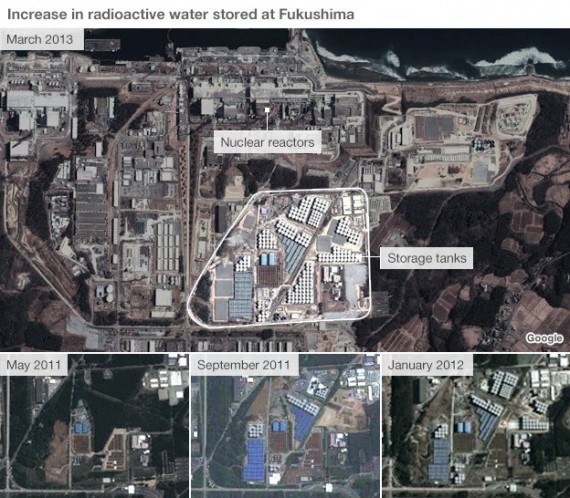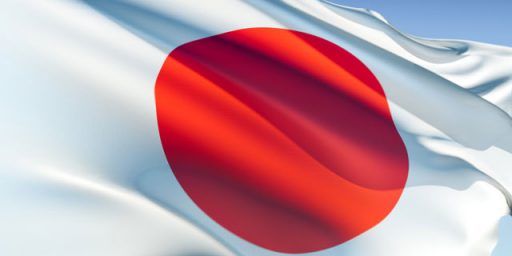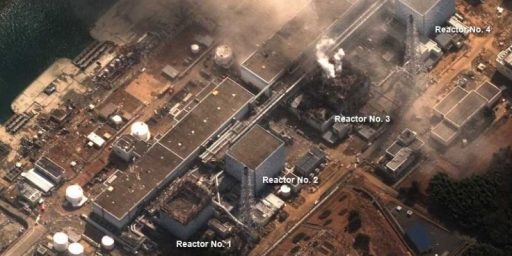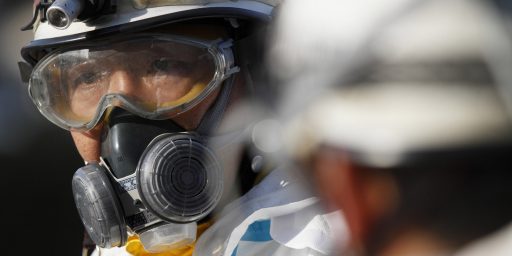Fukishima ‘Much Worse’ Than We Thought
Everyone knew the Fukushima disaster was bad. We likely underestimated how bad.
Everyone knew the Fukushima disaster was bad. We likely underestimated how bad.
BBC (“Fukushima leak is ‘much worse than we were led to believe’“):
A nuclear expert has told the BBC that he believes the current water leaks at Fukushima are much worse than the authorities have stated.
Mycle Schneider is an independent consultant who has previously advised the French and German governments.
He says water is leaking out all over the site and there are no accurate figures for radiation levels.
Meanwhile the chairman of Japan’s nuclear authority said that he feared there would be further leaks.
The ongoing problems at the Fukushima plant increased in recent days when the Tokyo Electric Power Company (Tepco) admitted that around 300 tonnes of highly radioactive water had leaked from a storage tank on the site.
The Japanese nuclear energy watchdog raised the incident level from one to three on the international scale that measures the severity of atomic accidents.
This was an acknowledgement that the power station was in its greatest crisis since the reactors melted down after the tsunami in 2011.
But some nuclear experts are concerned that the problem is a good deal worse than either Tepco or the Japanese government are willing to admit.
They are worried about the enormous quantities of water, used to cool the reactor cores, which are now being stored on site.
Some 1,000 tanks have been built to hold the water. But these are believed to be at around 85% of their capacity and every day an extra 400 tonnes of water are being added.
“The quantities of water they are dealing with are absolutely gigantic,” said Mycle Schneider, who has consulted widely for a variety of organisations and countries on nuclear issues.
“What is the worse is the water leakage everywhere else – not just from the tanks. It is leaking out from the basements, it is leaking out from the cracks all over the place. Nobody can measure that.
s






Can’t they reuse the existing radioactive cooling water and just make it more radioactive instead of making more radioactive water?
And honestly, it’s been two years. You’d think they could have built something that doesn’t leak to move the reactor cores to rather than leaving them in buildings that leak radioactive water all over the place.
This should be a(nother) wake up call to American operators: Empty your stored fuel pools into dry caskets now. It’s too late for Fukushima: Neither fish nor fowl nor robot can yet handle the intense radiation environment. Manufactured atop and surrounding two melted-down cores and two other supposedly intact “shut down” cores (shut down cores require active cooling) are spent fuel pools (also requiring active cooling), one of them a massive one packed with a mixture of reprocessed fuel (w/ plutonium) and non-reprocessed fuel. All waiting to spill into the warm Pacific waters.
The safety of nuclear power reminds me of something Nassim Taleb wrote about the enormous conglomeration of banks and how they spread risk: the risk chance becomes miniscule, but when something goes wrong, it becomes catastrophic.
@Stormy Dragon: I’m sure you must have a detailed plan to accomplish this. Why are you withholding it from the Japaneese Government?
If you listen to nuclear power promoters they talk about the minuscule chance of another Fukushima because, hey, what are the odds of both a tsunami and an earthquake at the same time affecting an American reactor? Anyone, and I mean anyone, who espouses this viewpoint is spewing BS. The reason the Fukushima reactors failed so catastrophically is that power was cut to their cooling systems for an extended period. There are 20+ reactors on US soil that would behave in virtually the same way if power was cut. Now, if the only way power could be cut was via the old tsunami/earthquake one-two, well, we are pretty well off. But if you can think of other ways for power to fail then you realize it is only a question of when, not if.
Any one else waiting for Godzilla to come up out of the Pacific sometime soon? I wonder what would have happened if we had spent an equal amount of money on safe renewable energy research that we spent on cleaning up problems at nuclear plants and cleaning up after oil spills, etc. you think we might havebeen able to come up with something better and safer by now?
@Stormy Dragon: It wouldn’t matter if they did implement a repumping process, it’s likely the system has leaked far more than the 300 tons which escaped from the storage tank identified in the article. Meanwhile much of it has found its way to our west coast, where the EPA and FDA say they will not test Pacific catch for fear it might be radioactive, and that would harm corporate profits.
So, Fukushima was more serious than the folks with a vested interest in telling us it wasn’t serious told us?
Forgive me if I assume that there is more to come from this.
“I wonder what would have happened if we had spent an equal amount of money on safe renewable energy research that we spent on cleaning up problems at nuclear plants and cleaning up after oil spills, etc. you think we might havebeen able to come up with something better and safer by now?”
http://www.freerepublic.com/focus/news/2251971/posts
How much more should we have spent and what assurance is there that outcomes would be different?
…miniscule risk… Pretty much what drunk drivers say to themselves when they get behind the wheel.
oh damn…wrong thread…
@Ben Wolf:
@MarkedMan: You do realize that Fukishima used reactors that were designed with slide rules back in the 50s right? We’re talking mark I containment and all kinds of old technology that should of been decommissioned years if not decades ago.
What you brought up is why we should be investing heavily in new reactors based upon current fourth gen reactor designs such as the LFTR design. These are designs that take into account the massive amount of scientific advancement over the last +60 years. These designs have passive fail safes that result in a controlled shutdown when power is lost. Unlike the ancient reactor designs we’re running currently across the country. LFTR tech not only is inherently safe but it’s also capable of burning radioactive waste..
None of this will happen though because as soon as you mention nuclear in public you’re shut down. That’s also why we’re still using such old reactors because it’s extremely difficult to get the proper paperwork done to upgrade to newer designs or construct newer safe reactors. So we’re basically stuck in a cycle where aging antiquated designs continue to poison the public’s opinion of new nuclear plants thus ensuring that we continue to rely on the old unsafe reactors and extremely deadly coal power.
@Matt: So I take that as an agreement that literally dozens of nuclear reactors around the world, including over 20 in the US, are based on dangerous and flawed technology? To the point that if the power goes out for more than a few hours bad things start to happen very fast, up to and beyond a core meltdown?
And is the wonderful nuclear technology community of businesses and regulating agencies warning people about that? Doing everything they can do to decommission those dangerous reactors? Or are they spending their time convincing people that not only are those reactors safe but, really for really this time, the next generation is even safer? But we have to make the manufacturers immune from liability or they won’t build them. Right.
I’m old enough to have been an adult during Three Mile Island and Chernobyl, and actually lived near the Ginna nuclear plant in upstate NY when it had its little problem. And I listened to the radio all day as the plant operators lied through their teeth, (no problem, the sirens were a scheduled test), got caught in the lie within minutes and then simply came out with a new lie. And then repeated that cycle three or four more times during the course of the day. On that one day I went from a supporter of nuclear power with some concerns, to a complete skeptic and have had my skepticism reinforce over and over again.
Basically yes as those reactors were designed long ago and should of been shuttered and replaced by now.
Some of them would very likely have extreme issues but some of them have been retrofitted to deal with that issue with varying degrees of potential for success.
Seems to me that the inability to get new nuclear reactors commissioned due to public opinion says all that needs to be said about that. There would be a decommissioning of these reactors if they were actually able to replace them but the concept of new nuclear reactors has been so poisoned in the eyes of public opinion that they can’t get any approval. So while the public is quite aware of the danger it’s the awareness combined with ignorance of the situation that has resulted in the current problem.
Well the fact is that all other forms of power generation kill FAR FAR more people a year then nuclear so technically they are much safer then coal/gas/etc. Immunity is not the issue it’s the ability to get the proper paper work completed by the various levels of government that makes it about impossible to build any new reactors from a time and cost standpoint.
WElcome to corporate America and how special interests work. Those same types of people lie to you on a daily basis about the safety of pretty much everything, Here’s the deal. WE need electrical generation capabilities to be increased greatly and wind/solar isn’t going to cut it.
Coal is currently accounting for 37% of our power generation capabilities. Coal also kills MANY more Americans every year directly and indirectly then nuclear power. Everything from the radioactive waste and pollution produced by coal mining (destroying entire ecosystems and polluting water sources permanently) to the radioactive fly ash and heavy metals (mercury arsenic etc) produced during the burning process. Even so called “clean” coal produces the same radiative and deadly waste as regular coal plants. THe “clean” plants just don’t release as much of the nasty stuff directly into the air instead they capture more of the nasty stuff in a physical form which must be stored somewhere. Yes producing and burning coal results in radioactive waste.
Natural Gas is about 30% of our current production level. You are probably already well aware of the dangers associated with natural gas production. Everything from the wholesale destruction of people’s water supplies (gasland) to exploding rigs in the gulf or in some cases in neighborhoods.
Nuclear is about 19% of our electrical production and also has the lowest rate of death out of all sources including renewable. Despite the fact that they are still operating antiquated and extremely outdated reactors there has been extremely few related deaths.
http://oi42.tinypic.com/2ryodiq.jpg
Note that nuclear has .04 deaths while rooftop solar is .44 and hydro is .10
Skepticism is good but it seems you’ve moved beyond that into the closed minded state of NOPE IT”S EVIL AND DANGEROUS AND I DON”T CARE ABOUT REALITY OR EVIDENCE OR FACT!!!..
Now if you would like to prove me wrong on that last point then I invite you to do some reading on the technology I’m discussing.
http://en.wikipedia.org/wiki/Liquid_fluoride_thorium_reactor
LFTR tech was investigated in the 50s and 60s as the reactor to power the nuclear aircraft when we thought nuclear powered long range bombers would be awesome..
If you don’t like that concept then there’s other options available from gen IV reactor designs.
http://en.wikipedia.org/wiki/Generation_IV_reactor
Regardless of what you think LFTRs are going to be operational in China in 2015 with additional designs slated for activation in 2015 and 2017. Japan, England, and the Czech Republic are also working on their own LFTRs.
To me Gen IV reactors are a stepping stone as we move to a more sustainable energy generation future. Wind is working pretty well so far but the technology isn’t capable of meeting our electrical demands. With the rapid rise of electric cars our thirst for energy will only increase exponentially. We need something to produce that power and I’d prefer something that burns our current stockpile of radioactive waste while having cold shutdown capabilities.
@Matt: Matt, it’s obvious that you believe very strongly in nuclear power and have done a great deal of reading on it. I try very hard to keep an open mind but in this case I don’t think we will convince each other, simply because we feel two different things are important. I’m guessing that you feel the technology behind the plant is the most important thing in this. On the other hand, to me the most important factor is the recklessnes and dishonesty of the nuclear industry. I don’t need to be convinced that nuclear power could be made safe. I accept that. I would need to be convinced that the current nuclear industry could make it safe.
Even the things you said above, while quite true, only reinforce my skepticism: “WElcome to corporate America and how special interests work. Those same types of people lie to you on a daily basis about the safety of pretty much everything”. “There would be a decommissioning of these reactors if they were actually able to replace them”. That last sentence sums it up: the nuclear industry places their parochial interests above the safety of the public. And despite what you say, the dangers are not well known. Remember, the Japanese admitted that one of the reasons they didn’t have adequate plans or equipment to deal with this event was because they felt that too much fore planning would scare the public and make it harder to build reactors.
Contrast all this with the FAA and the airline industry. Flying people through stormy skies in metal tubes is probably a lot more dangerous than nuclear power. But early on the regulators and the industry made a commitment that they would put safety above all else – and it paid off. They didn’t do it solely because they are wonderful people, but because they knew the public would eventually turn on them if they did anything else. The nuclear industry chose to go down a different path and they show no sign of turning back.
Looks to me like he sees good evidence for the subject matter at hand.
“feel” Doesn’t anyone think anymore?
Thumbs down for asking a legitimate question. (Saturday, August 24, 2013 at 20:11).
Thumbs up for being a critic. (Monday, August 26, 2013 at 11:41)
“Theirs not to reason why…”
(Apologies to Alfred Lord Tennyson and the six hundred.)
And if you really want to add joy to your visions of world holocaust, keep in mind that China is throwing up these babies in six-packs. Using Chinese engineering. Using Chinese construction companies. In earthquake-prone territory. In China.
Everyone comfy now?
@MarkedMan:
That exists in every industry so according to you we must allow no industry to exist. The coal industry being one of the worst by far as witnessed by the high yearly death toll and the various massive fly ash pond breakages which resulted in ecological and economic catastrophe for the regions..
It is safe and has been safe for some time when compared to our other energy sources. That safety record is with antiquated designs and straight up old reactors. Imagine how much safer things would be if they actually used something that wasn’t designed in the 50s with a slide rule?
SO instead of finding fault with the technology or facts relating to the actual energy creation method you resort to attacking the irresponsible members of the community. I could write you books worth of data on how irresponsible the coal industry is (the books already exist) and you don’t seem to care (neither do you care about the massive death tolls as a result). But god help us if someone in the nuclear industry is irresponsible because that means EVERYONE IS!!
You know what would of helped your complaint? People like you educating the public instead of scaremongering like you are in this thread. IT’s because of the scaremongers that they did what they did. You clearly admit that yourself.
That said it’s a poor excuse on their part and I believe they should be held criminally liable for their actions..
So basically what we have here is you scared of what could be and what might happen while I’m relying on what HAS happened and what the facts say. You’re basically living up to the stereotype of the anti-nuclear drones.
Just for the record I considered the reactors at Fukishima to be unsafe well before the accident. I also consider most reactors in the USA to be unsafe as they use the same or similar designs. If I had my way we’d be working on safe replacements immediately so that those reactors could be shut down asap.
I concede that to date the number of people that have died because of coal hugely outnumbers those from nuclear power. But for me a catastrophe that would, say, leave NYC uninhabitable for centuries is worse even if the total number of fatalities is less than a hundred years of coal mining. As I think I mentioned before, the aviation industry is a good example of a government/industry collaboration that has earned the trust of the public in dealing with potentially catastrophic operations.
@Stormy Dragon: They normally reuse the water but it goes through a process to remove certain properties (I’m relaying info from the fukushima diaries from memory and I am no physicist, just a layman.) however the speed at which the water is leaking out is monstrous and the filtration system in no way can keep up so they have been forced to store the water. The rate at which radiation has been leaking has been more than TEPCO can handle and so they have just continued to build more tanks. Damage control mode basically. The truth is they don’t know how to handle this situation and according to the F.D. they can’t even keep up with the storage capability and will run out of tanks sometime around December. Again this info is not verified fact but rather what I have gleaned from the Fukushima diaries. The point is that Japan and TEPCO have their hands full with damage control and no room left for problem solving. Also that they are losing the fight on damage control. At Chernobyl when the reactor blew, not only did it blow the lid off, but it also blew the bottom of the reactor core down. This released sand down under the core with the fuel and created lava which cooled and formed into a sort of glass radiation container. This was not planned, rather we got a lucky break. This is a break we will not get at Fukushima. The global community needs to come together to solve this IMHO.
@MarkedMan: So explain how that would happen?
Remember Chernobyl? You know the Soviet reactor which used a ridiculously unsafe reactor design and lacked any real containment? Yeah that accident resulted in the direct exposure of burning radioactive material to the open air. The amount of radiation and radioactive material released into the environment is still unprecedented. That said these days people regularly visit the exclusion zone. People actually still live in the exclusion zone and the other reactors on site were active till relatively recently.
That said if we built new safe reactors that wouldn’t even be a realistic worry. Although it would of course be prudent to assume the worst 🙂
@Greg Smith: Yes the Japanese need to shelve their pride for a bit and ask for the world’s help NOW..
http://www.scientificamerican.com/article.cfm?id=ancient-nuclear-reactor